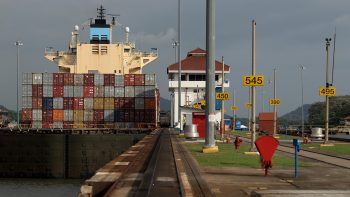
Shipping rates rise as Red Sea attacks continue
Shipping rates rise as Red Sea attacks continue

Ocean shipping rates have gone way up in recent days, largely because Yemen’s Houthi rebels continue to attack ships in the Red Sea following the onset of the Israel-Hamas war. The U.S. has countered, attacking anti-ship missiles.
About a third of global shipping typically passes through the Suez Canal and the Red Sea. But now, because of the attacks, more than 90% of ships are avoiding the route.
That’s one reason shipping containers are getting more expensive, noted Emily Benson at the Center for Strategic and International Studies.
“One of the biggest costs is time from point A to point Z,” she said. “It can take about two weeks longer for goods to transit around Africa, for example.”
For ships that are still passing through the Red Sea, insurance has also gotten more expensive as a result of the attacks.
But, Benson said that, for context, even though shipping rates have more than doubled in recent weeks, “they’re still significantly below where we were in 2021-2022. So this is nothing like what we experienced during COVID-19.”
At the height of the pandemic, shipping rates skyrocketed from less than $1,500 for a 40-foot container to more than $20,000 at one point. Now, they’re averaging around $3,000, though it depends on the route.
“It’s important to realize that shipping rates go up and down,” said Christine McDaniel, a senior research fellow at the Mercatus Center at George Mason University.
Companies know this and generally price some amount of volatility in. That’s why it usually takes a while before increases in shipping rates trickle down to the prices consumers pay for things, said McDaniel.
“It usually affects producer prices first, and then consumer prices later. But we’re not there yet,” she said.
That’s especially the case in the U.S. It’s a bit of a different story in Europe though, point out Mukul Krishna at Frost & Sullivan.
“Right now, Europe is being impacted a lot more than North America, largely because most of Europe’s shipping comes through those channels,” he said.
But Krishna said that most companies he’s talking to aren’t that concerned about these higher shipping costs — not yet, at least.
“They are not, as of now, seeing any long-term impact — ‘as of now being’ the key word over here,” Krishna said.
Because if the conflict drags on or spreads, he said that could change.
There’s a lot happening in the world. Through it all, Marketplace is here for you.
You rely on Marketplace to break down the world’s events and tell you how it affects you in a fact-based, approachable way. We rely on your financial support to keep making that possible.
Your donation today powers the independent journalism that you rely on. For just $5/month, you can help sustain Marketplace so we can keep reporting on the things that matter to you.


















